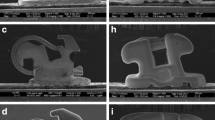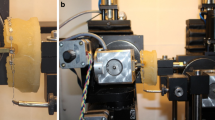Abstract
Purpose
To evaluate the effects of anodization on the friction behavior of beta-titanium (β-Ti) orthodontic archwires in conventional or self-ligating brackets in vitro.
Methods
β‑Ti archwires (0.018 × 0.025 inch) pre- and postanodization were tested in combination with 0.022-inch stainless steel conventional and self-ligating brackets. The surface composition and oxide thickness of the β‑Ti archwires pre- and postanodization were measured using Auger electron spectroscopy (AES) and transmission electron microscopy (TEM). Detailed surface topography and roughness were assessed using atomic force microscopy (AFM). Surface topographies of the β‑Ti archwires pre- and postanodization were examined using scanning electron microscopy (SEM). Friction was measured using a universal testing machine; the data were statistically analyzed.
Results
Postanodization, the identified titanium oxide layer on the surface of the β‑Ti archwires increased in thickness from 10 to 100 nm; at the same time, the values for surface roughness were significantly reduced by half (p < 0.001). The archwire surfaces post anodization were harder and had fewer scratches after the friction test. Anodization significantly reduced 23.77% of the static (p < 0.01) and 25.61% of the kinetic (p < 0.001) friction of the β‑Ti archwires in conventional brackets, while it significantly reduced 85.71% of the static and 84.38% of the kinetic friction (p < 0.01) in self-ligating brackets.
Conclusion
Anodization reduced the β‑Ti archwire friction, which was particularly more effective in combination with self-ligating brackets. The friction reduction via anodization could be attributed to the increased thickness, surface hardness, and decreased surface roughness of the titanium oxide layer.
Zusammenfassung
Ziel
Untersucht werden sollten die Auswirkungen einer Eloxierung auf das Reibungsverhalten von kieferorthopädischen Bogendrähten aus β‑Titan (β-Ti) in konventionellen bzw. selbstligierenden Brackets in vitro.
Methoden
β‑Ti-Bögen (0,018 × 0,02 Inch) vor und nach der Eloxierung wurden in Kombination mit konventionellen und selbstligierenden Brackets aus Edelstahl (0,022 Inch) getestet. Die Oberflächenzusammensetzung und die Oxiddicke der β‑Ti-Bögen vor und nach der Eloxierung wurden mit Auger-Elektronenspektroskopie (AES) und Transmissionselektronenmikroskopie (TEM) bestimmt. Die detaillierte Oberflächentopografie und -rauheit wurde mittels Rasterkraftmikroskopie (AFM) bewertet. Die Oberflächentopografien der β‑Ti-Bögen vor und nach der Eloxierung wurden mit dem Rasterelektronenmikroskop (REM) untersucht. Die Friktion wurde mit einer Universalprüfmaschine ermittelt; die Daten wurden statistisch ausgewertet.
Ergebnisse
Nach der Eloxierung nahm die Dicke der identifizierten Titanoxidschicht auf der Oberfläche der β‑Ti-Bögen von 10 auf 100 nm zu; gleichzeitig wurden die Werte für die Oberflächenrauheit signifikant um die Hälfte reduziert (p < 0,001). Nach der Eloxierung waren die Oberflächen der Bögen härter und hatten weniger Kratzer nach dem Friktionstest. Die Eloxierung reduzierte signifikant 23,77% der statischen (p < 0,01) und 25,61 % der kinetischen (p < 0,001) Reibung der β‑Ti-Bögen in konventionellen Brackets, während sie signifikant 85,71 % der statischen und 84,38 % der kinetischen Reibung (p < 0,01) in selbstligierenden Brackets reduzierte.
Schlussfolgerung
Die Eloxierung kann die Friktion des β‑Ti-Bogens reduzieren, besonders effektiv in Kombination mit selbstligierenden Brackets. Die Verringerung der Friktion durch die Eloxierung könnte auf die Zunahme der Dicke und der Oberflächenhärte sowie die Verringerung der Oberflächenrauhigkeit der Titanoxidschicht zurückzuführen sein.








Similar content being viewed by others
References
Goldberg AJ, Burstone CJ (1979) An evaluation of beta titanium alloys for use in orthodontic appliances. J Dent Res 58:593–600. https://doi.org/10.1177/00220345790580020901
Burstone CJ, Goldberg AJ (1980) Beta-titanium a new orthodontic alloy. Am J Orthod 77:121–132. https://doi.org/10.1016/0002-9416(80)90001-9
Kusy RP, Whitley JQ (1989) Effects of sliding velocity on the coefficients of friction in a model orthodontic system. Dent Mater 5:235–240. https://doi.org/10.1016/0109-5641(89)90067-5
Kusy RP, Whitley JQ (1990) Effects of surface roughness on the coefficients of friction in model orthodontic systems. J Biomech 23:913–925. https://doi.org/10.1016/0021-9290(90)90356-8
Kusy RP, Whitley JQ, Prewitt MJ (1991) Comparison of the frictional coefficients for selected arch wire-bracket slot combinations in the dry and wet states. Angle Orthod 61:293–302. https://doi.org/10.1043/0003-3219(1991)061<0293:COTFCF>2.0.CO;2
Drescher D, Bourauel C, Schumacher HA (1989) Frictional forces between bracket and arch wire. Am J Orthod Dentofacial Orthop 96:397–404. https://doi.org/10.1016/0889-5406(89)90324-7
Pizzoni L, Ravnholt G, Melsen B (1998) Frictional forces related to self-ligating brackets. Eur J Orthod 20:283–291. https://doi.org/10.1093/ejo/20.3.283
Nishio C, da Motta AFJ, Elias CN, Mucha JN (2004) In vitro evaluation of frictional forces between archwires and ceramic brackets. Am J Orthod Dentofacial Orthop 125:56–64. https://doi.org/10.1016/j.ajodo.2003.01.005
Tselepis M, Brockhurst P, West VC (1994) The dynamic frictional resistance between orthodontic brackets and arch wires. Am J Orthod Dentofacial Orthop 106:131–138. https://doi.org/10.1016/s0889-5406(94)70030-3
Aladjem A (1973) Anodic oxidation of titanium and its alloys. J Mater Sci 8:688–704
Sul YT, Johansson CB, Jeong Y, Albrektsson T (2001) The electrochemical oxide growth behavior on titanium in acid and alkaline electrolytes. Med Eng Phys 23:329–346. https://doi.org/10.1016/S1350-4533(01)00050-9
Sul YT, Johansson CB, Roser K, Albrektsson T (2002) Qualitative and quantitative observations of bone tissue reactions to anodized implants. Biomaterials 23:1809–1819. https://doi.org/10.1016/s0142-9612(01)00307-6
Santos E Jr, Kuromoto NK, Soares GA (2007) Mechanical properties of titanium films used as biomaterials. Mater Chem Phys 102:92–97. https://doi.org/10.1016/j.matchemphys.2006.11.010
Soares P, Mikowski A, Lepienski CM, Santos E Jr, Soares GA, Filho VS, Kuromoto NK (2008) Hardness and elastic modulus of TiO2 anodic films measured by instrumented indentation. J Biomed Mater Res Part B Appl Biomater 84B:524–530. https://doi.org/10.1002/jbm.b.30900
Yang CL, Chen FL, Chen SW (2006) Anodization of the dental arch wires. Mater Chem Phys 100:268–274. https://doi.org/10.1016/j.matchemphys.2005.12.042
Wu HJ, Huang LL, Chen SW, Liou EJW, Lee YT (2009) Surface characterization of anodized dental archwires and miniscrews. J Taiwan Inst Chem Eng 40:563–572. https://doi.org/10.1016/j.jtice.2009.03.009
Trigwell S, Hayden RD, Nelson KF, Selvaduray G (1998) Effects of surface treatment on the surface chemistry of NiTi alloy for biomedical applications. Surf Interface Anal 26:483–489. https://doi.org/10.1002/(SICI)1096-9918(199806)26:7〈483::AID-SIA388〉3.0.CO;2‑5
Wever DJ, Veldhuizen AG, de Vries J, Busscher HJ, Uges DRA, van Horn JR (1998) Electrochemical and surface characterization of a nickel-titanium alloy. Biomaterials 19:761–769. https://doi.org/10.1016/S0142-9612(97)00210-X
Ong JL, Lucas LC (1998) Auger electron spectroscopy and its use for the characterization of titanium and hydroxyapatite surfaces. Biomaterials 19:455–464. https://doi.org/10.1016/S0142-9612(97)00224-X
Kasemo B, Lausmaa J (1985) Aspect of surface physics on titanium implants. Swed Dent J Suppl 28:19–36
Kusy RP, Whitley JQ, de Araújo Gurgel J (2004) Comparisons of surface roughnesses and sliding resistances of 6 titanium-based or TMA-type archwires. Am J Orthod Dentofacial Orthop 126:589–603. https://doi.org/10.1016/j.ajodo.2003.09.034
Glaeser WA (1970) An engineer’s guide to friction. Defense Metal Information Center, Battelle Memorial Institute, Columbus, Ohio
Husmann P, Bourauel C, Wessinger M, Jager A (2002) The frictional behavior of coated guiding archwires. J Orofac Orthop 63:199–211. https://doi.org/10.1007/s00056-002-0009-5
Krishnan M, Saraswathy S, Sukumaran K, Abraham KM (2013) Effect of ion-implantation on surface characteristics of nickel titanium and titanium molybdenum alloy arch wires. Indian J Dent Res 24:411–417. https://doi.org/10.4103/0970-9290.118375
Burstone CJ, Frazin-Nia F (1995) Production of low-friction and colored TMA by ion implantation. J Clin Orthod 29:453–461.
Cash A, Curtis R, Garrigia-Majo D, McDonald F (2004) A comparative study of the static and kinetic frictional resistance of titanium molybdenum alloy archwires in stainless steel brackets. Eur J Orthod 26:105–111. https://doi.org/10.1093/ejo/26.1.105
D’Antò V, Rongo R, Ametrano G, Spagnuolo G, Manzo P, Martina R, Paduano S, Valletta R (2012) Evaluation of surface roughness of orthodontic wires by means of atomic force microscopy. Angle Orthod 82:922–928. https://doi.org/10.2319/100211-620.1
Aloysius AP, Vijayalakshmi D, Deepika, Soundararajan NK, Manohar VN, Khan N (2015) Comparative evaluation of frictional properties, load deflection rate and surface characteristics of different coloured TMA archwires—an invitro study. J Clin Diagn Res 9:ZC26–ZC29. https://doi.org/10.7860/JCDR/2015/16117.6962
Doshi UH, Bhad-Patil WA (2011) Static frictional force and surface roughness of various bracket and wire combinations. Am J Orthod Dentofacial Orthop 139:74–79. https://doi.org/10.1016/j.ajodo.2009.02.031
Alsabti N, Talic N (2020) Comparison of static friction and surface topography of low friction and conventional TMA orthodontic arch wires: an in-vitro study. Saudi Dent J. https://doi.org/10.1016/j.sdentj.2020.03.006
Ryan R, Walker G, Freeman K, Cisneros GJ (1997) The effects of ion implantation on rate of tooth movement: an in vitro model. Am J Orthod Dentofacial Orthop 112:64–68. https://doi.org/10.1016/S0889-5406(97)70275-0
Alexander L, Kommi PB, Arani N, Hanumanth S, Kumar VV, Sabapathy RS (2018) Evaluation of kinetic friction between regular and colored titanium molybdenum alloy archwires. Indian J Dent Res 29:212–216. https://doi.org/10.4103/ijdr.IJDR_817_16
Alsabti N, Bourauel C, Talic N (2020) Comparison of force loss during sliding of low friction and conventional TMA orthodontic archwires. J Orofac Orthop 82:218–225. https://doi.org/10.1007/s00056-020-00266-y
Cacciafesta V, Sfondrini MF, Ricciardi A, Scribante A, Klersy C, Auricchio F (2003) Evaluation of friction of stainless steel and esthetic self-ligating brackets in various bracket-archwire combinations. Am J Orthod Dentofacial Orthop 124:395–402. https://doi.org/10.1016/s0889-5406(03)00504-3
Krishnan M, Kalathil S, Abraham KM (2009) Comparative evaluation of frictional forces in active and passive self-ligating brackets with various archwire alloys. Am J Orthod Dentofacial Orthop 136:675–682. https://doi.org/10.1016/j.ajodo.2007.11.034
Huang TH, Luk HS, Hsu YC, Kao CT (2012) An in vitro comparison of the frictional forces between archwires and self-ligating brackets of passive and active types. Eur J Orthod 34:625–632. https://doi.org/10.1093/ejo/cjr065
Vinay K, Venkatesh MJ, Nayak RS, Pasha A, Rajesh M, Kumar P (2014) A comparative study to evaluate the effects of ligation methods on friction in sliding mechanics using 0.022″ slot brackets in dry state: an in vitro study. J Int Oral Health 6:76–83
Kumar D, Dua V, Mangla R, Solanki R, Solanki M, Sharma R (2016) Frictional force released during sliding mechanics in nonconventional elastomerics and self-ligation: an in vitro comparative study. Indian J Dent 7:60–65. https://doi.org/10.4103/0975-962X.184652
Sridharan K, Sandbhor S, Rajasekaran UB, Sam G, Ramees MM, Abraham EA (2017) An in vitro evaluation of friction characteristics of conventional stainless steel and self-ligating stainless steel brackets with different dimensions of archwires in various bracket-archwire combination. J Contemp Dent Pract 18:660–664. https://doi.org/10.5005/jp-journals-10024-2102
Thorstenson GA, Kusy RP (2001) Resistance to sliding of self-ligating brackets versus conventional stainless steel twin brackets with second-order angulation in the dry and wet (saliva) states. Am J Orthod Dentofacial Orthop 120:361–370. https://doi.org/10.1067/mod.2001.116090
Iwasaki LR, Beatty MW, Randall CJ, Nickel JC (2003) Clinical ligation forces and intraoral friction during sliding on a stainless steel archwire. Am J Orthod Dentofacial Orthop 123:408–415. https://doi.org/10.1067/mod.2003.61
Acknowledgements
The authors thank the financial support of Chang Gung Tsing Hua cooperation project (Grant GMRPG361011) and the National Science Council of Taiwan (Grant NSC 96-2221-E-007-001).
Funding
This study was supported by the grants from Chang Gung Tsing Hua cooperation project (Grant CMRPG361011) and the National Science Council of Taiwan (Grant NSC 96-2221-E-007-001).
Author information
Authors and Affiliations
Contributions
Yueh-Tse Lee conceptualized the study design, performed the archwire anodization and friction test, analyzed the data for the work, and wrote the manuscript. Eric Jein-Wein Liou conceptualized the study, interpreted the data for the work, and revised the manuscript. Li-Ling Huang, Hsin-Jay Wu, and Sinn-Wen Chen conducted the archwire anodization and friction test, and analyzed the data for the work. All authors read and approved the final manuscript.
Corresponding author
Ethics declarations
Conflict of interest
Y.-T. Lee, E.J.-W. Liou, L.-L. Huang, H.-J. Wu and S.-W. Chen declare that they have no competing interests.
Ethical standards
For this article no studies with human participants or animals were performed by any of the authors. All studies performed were in accordance with the ethical standards indicated in each case.
Additional information
Publisher’s Note
Springer Nature remains neutral with regard to jurisdictional claims in published maps and institutional affiliations.
Availability of data and material
The datasets used and/or analyzed during the current study are available from the corresponding author on reasonable request.
Rights and permissions
About this article
Cite this article
Lee, YT., Liou, E.JW., Huang, LL. et al. Effect of anodization on friction behavior of β‑titanium orthodontic archwires. J Orofac Orthop 84, 225–234 (2023). https://doi.org/10.1007/s00056-021-00347-6
Received:
Accepted:
Published:
Issue Date:
DOI: https://doi.org/10.1007/s00056-021-00347-6




